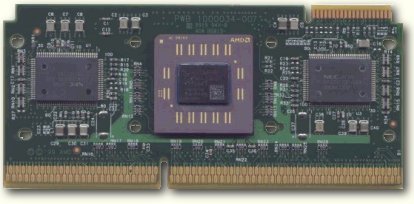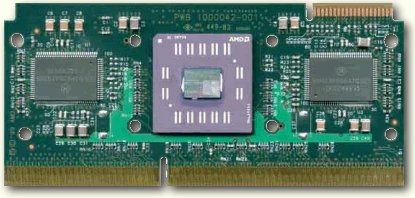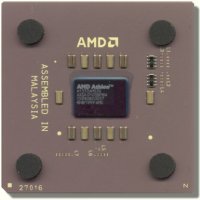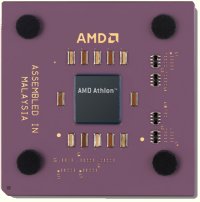The First Palomino: AMD Releases Mobile Athlon 4
Why Athlon 4?
At first, Palomino's new name 'Athlon 4' makes you wonder if you somehow missed Athlon 2 and Athlon 3, but you can imagine that AMD has to have some sensible justification for the jump from 'Athlon' to 'Athlon 4'. Technically, the Palomino core is indeed AMD's fourth officially released Athlon version.
The first Athlon came with a core manufactured in 0.25 micron process, which therefore had quite a large die, despite the fact that it had to rely on external L2-cache modules:
Athlon No. 2 was quietly replacing the 0.25 micron die with a 0.18 micron pendant in the first half of 2000. It still came in the SlotA-cartridge, because it required external L2-cache modules as well:
Thunderbird was AMD's third Athlon core version. It marked the step from SlotA to SocketA, because it came with integrated second level cache, while remaining to be manufactured in 0.18-mircon process. 'Thunderbird', or 'Athlon No. 3', has so far been the most successful AMD-processor of all time:
Palomino, or 'Athlon 4' has a completely redesigned die, although it certainly doesn't mark a radical change in terms of features or performance, as you will see. The die size was slightly increased over 'Thunderbird', while the shape of the die changed quite a bit:
It is obvious that the above explanation for 'Palomino's new name doesn't exactly tell the whole story. The name 'Athlon 4' is obviously targeting its direct competitor from Intel, the 'Pentium 4'. The new name makes it much easier for AMD's PR-department to make customers understand that 'Palomino' is an equally valuable product as Intel's flagship processor. It's not just 'Pentium 4' vs. 'Athlon', but 'Athlon FOUR'.
Get Tom's Hardware's best news and in-depth reviews, straight to your inbox.
Current page: Why Athlon 4?
Prev Page The First Palomino - For Notebooks Only! Next Page The Technology Behind 'Athlon 4'


